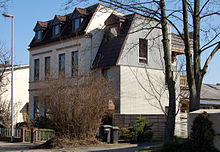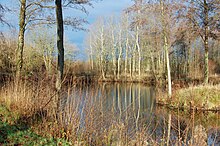Steel network: The house on the Stör
| Episode in the series Stahlnetz | |
|---|---|
| Original title | The house on the sturgeon |
| Country of production | Federal Republic of Germany |
| original language | German |
| Production company |
Northern German Radio |
| length | 84 minutes |
| classification | Episode 17 ( List ) |
| First broadcast | May 26, 1963 on Das Erste |
| Rod | |
| Director | Jürgen Roland |
| script | Wolfgang crowd |
| camera | Walter Fehdmer |
| cut | Manfred Jentsch |
| occupation | |
| |
The house on the sturgeon from 1963 is one of the most famous crime films from the series Stahlnetz , which were produced between 1958 and 1968 by NDR under the direction of Jürgen Roland . Like all episodes in the series, this film was based on a true story in which only the place and people of the plot were changed. The original case here was the Ruth Blaue case. In the film, Rudolf Platte plays the investigating detective and Andrea Grosske his colleague. Other roles include Mady Rahl , Richard Lauffen , Harry Wüstenhagen , Ernst H. Hilbich , Kurt Jaggberg and Katrin Schaake .
It was first broadcast on May 26, 1963 on ARD and, like most films in this series, became a street sweeper .
action
The story begins at the railway station in the Schleswig-Holstein city of Itzehoe , where the head of the homicide commission there, Oberkommissar Roggenburg, and the head of the female criminal police, Ms. Johannson, embark on a business trip by train that takes them via Hamburg-Altona and Munich to Bad Tölz . There, the perpetrators of a murder case that took place 17 years ago are to be arrested. Ms. Johannson, who has no knowledge of the case, is given all the details by her colleague during the long train journey.
In the extremely cold winter of 1947 , two children found the body of a murdered man in the waterhole of a frozen fish pond near Meldorf , who had obviously been lying in the water for many months. The body is in a duffel bag closed with welding wire and weighted down with bricks. The police investigations lead to no result. Even the identity of the dead cannot be established. So the case is filed away after a relatively short period of time.
Roggenburg, who only came to Itzehoe in 1952, takes on the unsolved cases from the past. A few years later he happened upon the first clue about the old murder case. Now arduous detailed work begins for him. Of the more than 100 people reported missing at the time, only two remain after the review to fit the description of the dead person. The murdered man can be identified as Helmut Noack using a gold tooth. The first lead leads to the burglar Eduard Vollmer, who was already in prison in 1947 because of the testimony of his ex-girlfriend Selma. But Roggenburg soon establishes his innocence in the crime.
The detective then examines the dead person's private environment more closely. The investigations show that Noack, who returned to Meldorf several months after the end of the war , planned to open a haulage company. According to his wife, he wanted to go to the Eastern Zone , where he believed he could get a truck cheaply. Roggenburg learns, however, that a friend from Hamburg was able to get him an inexpensive truck, which would have made the risky trip "into the zone" superfluous. Roggenburg also hears that a sculptor named Reinhold was living with his wife as a subtenant before Noack's return home. The officer, who continues to follow up even the smallest lead, finally finds the solution to the case in a remote house on the small river Stör .
In the meantime, the two detectives have arrived at their destination. The murdered man's wife is arrested as the perpetrator at a carnival ball. Her lover and accomplice Reinhold escapes arrest by suicide.
The resolution
Mrs. Noack had supposedly bought the house on the Stör for her husband. There Roggenburg found the remains of unsuccessful sculptures: Made by Mr. Reinhold, with the face of Mrs. Noack: So she must have lived there with Mr. Reinhold immediately after the murder of her husband - before she went to southern Germany. In addition, the same welding wire was used for the sculptures that was used to tie the improvised body bag together.
The judgment
At the end of the film, the judgment and the reasons for the judgment are mentioned in a postscript. It literally means:
“On May 24th, the jury court in Itzehoe sentenced Hildegard Noack to life imprisonment and at the same time deprived of her civil rights for life. Her accomplice Reinhold had evaded his earthly judges by suicide. If the court admitted that the fatal blows were not carried out by Mrs. Noack, but by her lover Reinhold, or that they struck first, then, although Noack was already dead, Mrs. Noack also hit hers with the ax If the man was hit, it remained irrelevant because of the assessment of the punishment according to § 211 StGB , because according to § 49 StGB the perpetrator was given knowingly help to commit an act threatened as a crime or misdemeanor through advice or deed. "
Remarks
The film has two storytellers. On the one hand, the voice from the off, which, as with all Stahlnetz episodes, tells the basics about the case. On the other hand, Chief Commissioner Roggenburg, who informs his colleague about each of his steps in the case. This means that the main actor Rudolf Platte can be seen in almost every scene. All other actors, with the exception of Andrea Grosske , only have short, mostly one-off appearances. The main culprit Reinhold is disguised as a clown at the carnival ball shortly before the end of the film (without dialogue) and then seen sitting at a table as a corpse; his accomplice ( Mady Rahl ) can only be seen during an interrogation in Itzehoe and later during her arrest.
As in many Stahlnetz episodes, well-known Hamburg folk actors also appear here . This time it's Otto Lüthje and Henry Vahl from the Ohnsorg Theater and Christa Siems from the St. Pauli Theater . Henry Vahl in particular, as forensic doctor Professor Bildt, won over the audience in his rather untypical role.
The real criminal case
After the war, Ruth Blaue opened the Cafe Blaue Stube with an attached bookshop in Elmshorn in the absence of her husband John Blaue . In 1946, Blaue fell in love with the 10 years younger and also art-loving sculptor Horst Buchholz. He moved in with her and carved Madonnas with the face of Ruth Blaue. John Blaue was originally a trained freight forwarder and later a seaman.
After the end of the war, John Blaue worked for the British in mine clearance in the North Sea. As part of this activity, he came sporadically (about every 4 weeks) to his wife in Elmshorn. In 1946 he returned there for good, he was never a prisoner of war. He moved back in with his wife, the lover stayed too. “Mostly I was for my husband for bed. I had to be a housewife and wife. I really hadn't been at home knitting all the time. My life went on in the meantime, ”she said during interrogation.
In November 1946, John Blaue suddenly disappeared. His wife Ruth Blaue told the neighbors that he had moved to the east zone to open a shipping company. After a while, Ruth Blaue filed a missing person report.
In the summer of 1947, Gerd Killisch discovered a duffel bag tied with wire in the shallow pool in the village of Klein Nordende near Elmshorn in Schleswig-Holstein. It contained the half-decayed corpse of a man. A connection with the missing John Blaue was initially not established. The head found in a duffel bag had a gold tooth, Ruth Blaue denied that her husband had one.
In 1955 the duffel bag brought the truth to light. The wire that was used to tie up the duffel bag corresponded to the type of wire that Horst Buchholz used to pack his works of art. Ruth Blaue and Horst Buchholz had meanwhile settled in the Black Forest and were arrested. There were statements of both, multiple confessions and repeated revocations. It remained unclear whether both of them wanted to take on the murder alone out of love. Buchholz committed suicide while in custody. From then on, Ruth Blau accused him of being a sole perpetrator.
John Blau was probably anesthetized with a sleeping pill, then killed with five ax blows. Who taught the victim the fatal blows could not be clarified. The couple transported the wrapped corpse on a bicycle to the swimming pool and then celebrated a birthday party.
In November 1955 Ruth Blaue was sentenced by the court in Itzehoe to life imprisonment and loss of civil rights for the joint murder of John Blaue. In early 1969 she was released early from prison because of cancer. She denied any involvement in the murder until her death on December 27, 1972.
media
The house on the sturgeon has appeared in two versions:
- The film version on DVD as part of the series box Stahlnetz published in 2005 (slipcase of 4 with all 22 episodes), ISBN 3-86635-005-8 .
- The audio play version as CD in Der Audio Verlag , Berlin 2005, ISBN 3-89813-459-8 . It contains the revised soundtrack of the film. In some cases, scenes that only serve as a framework in the film but do not advance the plot were cut (e.g. the scene with the girl on the train).
In 2009 an episode in the ARD documentary series Wenn Frauen morden entitled Madonna or Murderer was dedicated to the murder case (first broadcast on January 12).
literature
- Klaus Alberts: The murderer Ruth Blaue. Schleswig-Holstein's puzzling post-war case. Boyens, Heide 2011, ISBN 978-3-8042-1329-6 .
- 1946: The murder of John Blaue - Jürgen Roland turns the case into a crime thriller. In: Hamburger Abendblatt. November 23, 2005.
Web links
- Steel mesh: The house on the sturgeon in the Internet Movie Database (English)
- Einestages.de on the case of Ruth Blaue , accessed on September 11, 2012.
- Appraisal of the case in the Hamburger Abendblatt , accessed on September 11, 2012.
- The Murderer Madonna: When her husband came home from the war, she made her cruel plan
|
previous episode 28./30. November 1962: track 211 |
Steel network consequences |
next episode June 16, 1964: Deer |



